RBSE Solutions for Class 12 Physics Chapter 11 Dual Nature of Radiation and Matter
Rajasthan Board RBSE Solutions for Class 12 Physics Chapter 11 Dual Nature of Radiation and Matter Textbook Exercise Questions and Answers.
Rajasthan Board RBSE Solutions for Class 12 Physics in Hindi Medium & English Medium are part of RBSE Solutions for Class 12. Students can also read RBSE Class 12 Physics Important Questions for exam preparation. Students can also go through RBSE Class 12 Physics Notes to understand and remember the concepts easily. Browsing through wave optics important questions that include all questions presented in the textbook.
RBSE Class 12 Physics Solutions Chapter 11 Dual Nature of Radiation and Matter
RBSE Class 12 Physics Dual Nature of Radiation and Matter Textbook Questions and Answers
Question 11.1
Find the
(a) maximum frequency and
(b) minimum wavelength of X-rays produced by 30 kV electrons.
Answer:
Given V0 = 30 kV = 30 x 103 V
vmax =?
λmin =?
(a) Since kmax = eV0
So hvmax = eV0
or vmax = \(\frac{e \mathrm{~V}_0}{h}\)
or vmax = \(\frac{1.6 \times 10^{-19} \times 30 \times 10^3}{6.62 \times 10^{-34}}\)
= 7.24 x 1018 Hz
(b) λmin = \(\frac{c}{v_{\max }}=\frac{3 \times 10^8}{7.25 \times 10^{18}}\)
= 0.041 x 10-9
or λmin = 0.041 nm.

Question 11.2.
The work function of cesium metal is 2.14 eV. When light of frequency 6 x 1014 Hz is incident on the metal surface, photoemission of electrons occurs. What is the
(a) maximum kinetic energy of the emitted electrons,
(b) stopping potential and
(c) maximum speed of the emitted photoelectrons?
Answer:
Given W0 = 2.14 eV
= 2.14 x 1.6 x 10-19 J
or W0 = 3.424 x 10-19 J
(a) Given v = 6 x 1014 Hz
∴ kmax = hv - W0
= 6.62 x 10-34 x 6 x 1014 - 3.424 x 1019
= 3.972 x 10-19 - 3.424 x 10-19
= 0.548 x 10-19 J.
= \(\frac{0.548 \times 10^{-19}}{1.6 \times 10^{-19}}\) eV
= 0.342 eV
(b) Since eV0 = kmax
∴ V0 = \(\frac{k_{\max }}{e}=\frac{0.54 \times 10^{-19}}{1.6 \times 10^{-19}}\)
or V0 = 0.342 V
(c) Since \(\frac{1}{2}\)mvmax2 = kmax
∴ vmax2 = \(\frac{2 k_{\max }}{m}\)
= \(\frac{2 \times 0.54 \times 10^{-19}}{9.1 \times 10^{-31}}\) = 0.1186
or vmax = 0.345 x 106 ms-1
= 345 km s-1.
Question 11.3.
The photoelectric cut-off voltage in a certain experiment is 1.5 V. What is the maximum kinetic energy of photoelectrons emitted?
Answer:
Given V0 = 1.5 V
Since kmax = eV0
= 1.5 eV
= 1.5 x 1.6 x 10-19 J
= 2.4 x 10-19 J.
Question 11.4.
Monochromatic light of wavelength 632.8 nm is produced by a helium-neon laser. The power emitted is 9.42 mW.
(а) Find the energy and momentum of each photon in the light beam.
(b) How many photons per second, on average, arrive at a target irradiated by this beam? (Assume the beam to have a uniform cross-section which is less than the target area), and
(c) How fast does a hydrogen atom have to travel in order to have the same momentum as that of the photon?
Answer:
Given λ = 632.8 nm
= 632.8 x 10-9 m
P = 9.42 mW = 9.42 x 10-3 W
(a) E = \(\frac{h c}{\lambda}\)
or E = \(\frac{6.63 \times 10^{-34} \times 3 \times 10^8}{632.8 \times 10^{-9}}\)
= 3.14 x 10-19 J
p = \(\frac{\mathrm{E}}{c}=\frac{3.14 \times 10^{-19}}{3 \times 10^8}\)
= 1.05 x 10-27 kg ms-1
(b) If n the number of photons emitted per second, then
n = \(\frac{\mathrm{P}}{\mathrm{E}}\)
or n = \(\frac{9.42 \times 10^{-3}}{3.14 \times 10^{-19}}\)
= 3 x 1016 photons/s
(c) Velocity of hydrogen atom
v = \(\frac{p}{m}=\frac{1.05 \times 10^{-27}}{1.67 \times 10^{-27}}\)
= 0.63 ms-1

Question 11.5.
The energy flux of sunlight reaching the surface of the earth is 1.388 x 103 W/m2. How many photons (nearly) per square metre are incident on the Earth per second? Assume that the photons in the sunlight have an average wavelength of 550 nm.
Answer:
Energy flux = 1.388 x 103 W/m2
λ = 550 nm = 550 x 10-9 m
∴ number of photons per square meter incident per second
N = \(\frac{\text { Energy flux }}{\text { Wavelength }}\)
= \(\frac{1.388 \times 10^3}{550 \times 10^{-9}}\) = 4 x 1021 photon/m2s.
Question 11.6.
In an experiment on the photoelectric effect, the slope of the cutoff voltage versus frequency of incident light is found to be 4.12 x 10-15 Vs. Calculate the value of Planck’s constant.
Answer:
Given, slope of graph = 4.12 x 10-15 Vs
Since, slope of graph = \(\frac{h}{e}\)
∴ h = e x slope of graph
= 1.6 x 10-19 x 4.12 x 10-15
= 6.592 x 10-34 Js.
Question 11.7.
A 100 W sodium lamp radiates energy uniformly in all directions. The lamp is located at the center of a large sphere that absorbs all the sodium light which is incident on it. The wavelength of sodium light is 589 nm. (a) What is the energy per photon associated with sodium light? (b) At what rate are the photons delivered to the sphere?
Answer:
Given P = 100 W
λ = 589 nm
= 589 x 10-9 m
(a) Energy per photon,
E = hv = \(\frac{h c}{\lambda}\)
= \(\frac{6.62 \times 10^{-34} \times 3 \times 10^8}{589 \times 10^{-9}}\)
= 3.38 x 10-19 J
= \(\frac{3.38 \times 10^{-19}}{1.6 \times 10^{-19}}\)
= 2.11 eV.
(b) n = \(\frac{\mathrm{P}}{\mathrm{E}}=\frac{100}{3.38 \times 10^{-19}}\)
= 2.96 x 1020
= 3 x 1020 photons/s.
Question 11.8.
The threshold frequency for a certain metal is 3.3 x 1014 Hz. If light of frequency 8.2 x 1014 Hz is incident on the metal, predict the cut-off voltage for the photoelectric emission.
Answer:
Given v0 = 3.3 x 1014 Hz
v = 8.2 x 1014 Hz
Since eV0 = hv - hv0
So V0 = \(\frac{h}{e}\) (v - v0)
= \(\frac{6.62 \times 10^{-34}}{1.6 \times 10^{-19}}\) x 8.2 x 1014 - 3.3 x 1014
= 4.14 x 10-15 x 4.9 x 1014
= 2.02 V
= 2.0 V.

Question 11.9.
The work function for a certain metal is 4.2 eV. Will this metal give photoelectric emission for incident radiation of wavelength 330 nm?
Answer:
Given W0 = 4.2 eV
= 4.2 x 1.6 x 10-19 J
W0 = 6.72 x 10-19 J
λ0 = 330 nm
= 330 x 10-9 m
Since W0 = hv0 = \(\frac{h c}{\lambda_0}\)
or λ0 = \(\frac{h c}{\mathrm{~W}_0}\)
= \(\frac{6.62 \times 10^{-34} \times 3 \times 10^8}{6.72 \times 10^{-19}}\)
λ0 = 295 x 10-9
So \(\frac{v}{v_0}=\frac{c}{\dot{\lambda}} \cdot \frac{\dot{\lambda}_0}{c}=\frac{\dot{\lambda}_0}{\dot{\lambda}}\)
= \(\frac{295 \times 10^{-9}}{330 \times 10^{-9}}\) < 1
or v < v0
∴ no photoelectric emission will take place.
Question 11.10.
Light of frequency 7.21 x 1014 Hz is incident on a metal surface. Electrons with a maximum speed of 6.0 x 105 m/s are ejected from the surface. What is the threshold frequency for the photoemission of electrons?
Answer:
Given v = 7.21 x 1014 Hz
vmax = 6.0 x 105 ms-1
v0 =?
Since kmax = hv - hv0
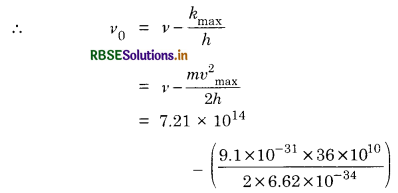
= 7.21 x 1014 - 2.48 x 1014
= 4.71 x 1014 Hz.
Question 11.11.
Light of wavelength 488 nm is produced by an argon laser which is used in the photoelectric effect. When light from this spectral line is incident on the emitter, the stopping (cut-off) potential of photoelectrons is 0.38 V. Find the work function of the material from which the emitter is made.
Answer:
Given λ = 488 nm
= 488 x 10-9 m
V0 = 0.38 V
W0 =?
Since W0 = hv - eV0
So W0 = \(\frac{h c}{\lambda}\) - eV0
or W0 = \(\frac{6.62 \times 10^{-34} \times 3 \times 10^8}{488 \times 10^{-9}}\) - 1.6 x 10-19 x 0.38
= 4.08 x 10-19 - 0.608 x 10-19
= 3.472 x 10-19 J
= \(\frac{3.472 \times 10^{-19}}{1.6 \times 10^{-19}}\) = 2.17 eV
Question 11.12.
Calculate the
(a) momentum, and
(b) de-Broglie wavelength of the electrons accelerated through a potential difference of 56 V.
Answer:
Given V = 56 volt
P =?, λ =?
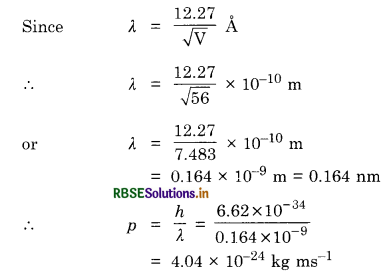
Question 11.13.
What is the
(a) momentum,
(b) speed and
(c) de-Broglie wavelength of an electron with kinetic energy of 120 eV?
Answer:
Given E = 120 eV = 120 x 1.6 x 10-19 J = 192 x 10-19 J
p =?, v =?
λ =?

= 5.91 x 10-24 kg ms-1
(b) v = \(\frac{p}{m}\)
or v = \(\frac{5.91 \times 10^{-24}}{9.1 \times 10^{-31}}\)
= 6.5 x 106 ms-1
(c) λ = \(\frac{h}{p}=\frac{6.62 \times 10^{-34}}{5.91 \times 10^{-24}}\)
= 1.12 x 10-10 m
or λ = 0.112 nm.

Question 11.14.
The wavelength of light from the spectral emission line of sodium is 589 nm. Find the kinetic energy at which
(а) an electron and
(b) a neutron would have the same de-Broglie wavelength.
Answer:
Given λ = 589 nm = 589 x 10-9 m
(a) K.E. of electron,
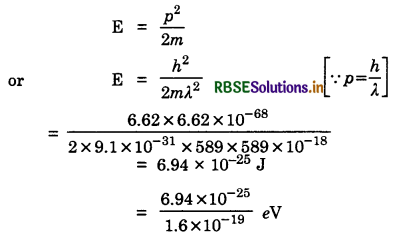
= 4.34 x 10-6 eV = 4.34 µeV
(b) E = \(\frac{h^2}{2 m \lambda^2}\)
= \(\frac{6.62 \times 6.62 \times 10^{-34}}{2 \times 1.67 \times 10^{-27} \times 589 \times 589 \times 10^{-18}}\)
or E = 3.78 x 10-28 J
= \(\frac{3.78 \times 10^{-28}}{1.6 \times 10^{-19}}\)
= 2.36 x 10-9 eV = 2.36 neV.
Question 11.15.
What is the de-Broglie wavelength of
(а) a bullet of mass 0.040 kg traveling at the speed of 1.0 km/s,
(b) a ball of mass 0.060 kg moving at a speed of 1.0 m/s and
(c) a dust particle of mass 1.0 x 10-9 kg drifting with a speed of 2.2 m/s?
Answer:
(a) m = 0.040 kg,
v = 1.0 km/s = 1000 ms-1
∴ λ = \(\frac{h}{m v}=\frac{6.62 \times 10^{-34}}{0.04 \times 1000}\)
or λ = 0.1655 x 10-34 m
= 1.7 x 10-35 m
(b) m = 0.060 kg, v = 1.0 ms-1
∴ λ = \(\frac{h}{m v}=\frac{6.62 \times 10^{-34}}{0.06 \times 1}\)
= 1.1 x 10-32 m
(c) m = 1.0 x 10-9 kg, v = 2.2 ms-1
∴ λ = \(\frac{h}{m v}=\frac{6.62 \times 10^{-34}}{10^{-9} \times 2.2}\)
= 3.0 x 10-23 m.
Question 11.16.
An electron and a photon each have a wavelength of 1.00 nm. Find:
(a) their momenta
(b) the energy of the photon and
(c) the kinetic energy of electron.
Answer:
Given λph = λe = λ = 1.00 nm = 10-9 m
(a) p = pph = pe = \(\frac{h}{\lambda}=\frac{6.62 \times 10^{-34}}{10^{-9}}\)
= 6.62 x 10-25 kg ms-1
(b) Eph = pc = 6.63 x 10-25 x 3 x 108
= 19.89 x 10-17 J
= \(\frac{19.89 \times 10^{-17}}{1.6 \times 10^{-19}}\) eV
= 1.243 x 103 eV = 1.243 keV
(c) Ee = \(\frac{p_e^2}{2 m}=\frac{6.62 \times 6.62 \times 10^{-50}}{2 \times 9.1 \times 10^{-31}}\)
= 2.415 x 10-19 J
= \(\frac{2.415 \times 10^{-19}}{1.6 \times 10^{-19}}\) = 1.51 eV.
Question 11.17.
(a) For what kinetic energy of a neutron will the associated de-Broglie wavelength be 1.40 x 10-10 m?
(b) Also find the de-Broglie wavelength of a neutron, in thermal equilibrium with matter, having an average kinetic energy of \(\frac{3}{2}\) kT at 300 K.
Answer:
(a) Given λ = 1.40 x 10-10 m, K.E. =?
Kinetic energy of neutrons,
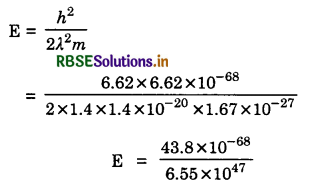
= 6.687 x 10-21 J
or E = \(\frac{6.687 \times 10^{-21}}{1.6 \times 10^{-19}}\) eV
= 4.179 x 10-2 eV
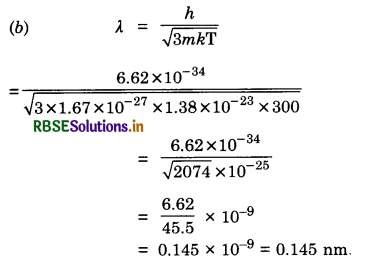
Question 11.18.
Show that the wavelength of electromagnetic radiation is equal to the de-Broglie wavelength of its quantum (Photon).
Answer:
Since de-Broglie wavelength of a photon is
λ = \(\frac{h}{p}\)
But p = \(\frac{h v}{c}\)
∴ λ = \(\frac{h}{h v / c}=\frac{c}{v}\)
Which is the wavelength of electromagnetic radiation.

Question 11.19.
What is the de-Broglie wavelength of a nitrogen molecule in air at 300 K? Assume that the molecule is moving with the root-mean-square speed of molecules at this temperature. (Atomic mass of nitrogen = 14.0076 u).
Answer:
Given mass of nitrogen molecule
= 2 x 14.0076 u
= 28.0152 x 1.67 x 10-27 kg
T = 300 K
Since de-Broglie wavelength,
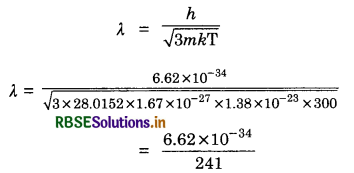
= 0.0275 x 10-9
= 0.028 nm.
ADDITIONAL EXERCISES
Question 11.20.
(a) Estimate the speed with which electrons emitted from a heated emitter of an evacuated tube impinge on the collector maintained at a potential difference of 500 V with respect to the emitter. Ignore the small initial speeds of the electrons. The ‘specific charge’ of the electron i.e. its e/m is given to be 1.76 x 1011 C kg-1.
(b) Use the same formula you employ in (a) to obtain electron speed for a collector potential of 10 MV. Do you see what is wrong? In what way is the formula to be modified?
Answer:
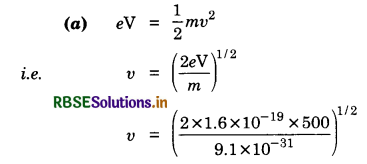
v = 1.33 x 107 ms-1.
(b) ) If we use the same formula with V = 107 volts, we get, v = 1.88 x 109 ms-1. This is clearly wrong since nothing can move with a speed greater than the speed of light (c = 3 x 108 ms-1). Actually, the above formula for kinetic energy \(\left(\frac{1}{2} m v^2\right)\) is valid only when \(\frac{v}{c}\) << 1. At very high speeds when \(\frac{v}{c}\) is comparable to (though always less than) 1, we come to the relativistic domain where the following formulae are valid:
Relativistic momentum,
p = mv
Total energy, E = mc2
Kinetic energy, T = mc2 - m0c2,
mc2 = 0.51 + 10 = 10.51 MeV
\(\frac{m_0}{\sqrt{1-\frac{v^2}{c^2}}}\)c2 = 10.51
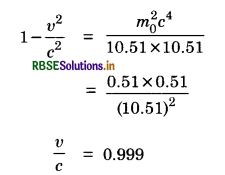
or v = 0.999 c.
Question 11.21.
(a) A monoenergetic electron beam with electron speed of 5.20 x 106 ms-1 is subjected to a magnetic field of 1.30 x 10-4 T normal to the beam velocity. What is the radius of the circle traced by the beam, given e/m for electron equals 1.76 x 1011 C kg-1?
(b) Is the formula you employ in (a) valid for calculating radius of the path of a 20 MeV electron beam? If not, in what way is it modified?
Note: Exercises 11.20(b) and 11.21 (b) take you to relativistic mechanics which is beyond the scope of this book. They have been inserted here simply to emphasize the point that formulae you use in part (a) of the exercises are not valid at very high speeds or energies. See answer at the end to know what 'very high speed or energy' means?
Answer:
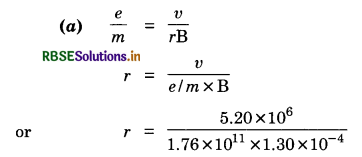
= 0.227 m = 22.7 cm.
(b) No, as explained above, a 20 MeV electron moves at a relativistic speed. Consequently, the non-relativistic formula r = \(\frac{m v}{e \mathrm{~B}}\) is not valid.
The relativistic formula is
r = \(\frac{p}{e \mathrm{~B}}=\frac{m v}{e \mathrm{~B}}\)
or r = \(\frac{m_0 v}{e \mathrm{~B} \sqrt{1-\frac{v^2}{c^2}}}\).
Question 11.22.
An electron gun with its collector at a potential of 100 V fires out electrons in a spherical bulb containing hydrogen gas at low pressure (~10-2 mm of Hg). A magnetic field of 2.83 x 10-4 T curves the path of the electrons in a circular orbit of radius 12.0 cm. Determine e/m from the data.
Answer:
We have
eV = \(\frac{1}{2}\)mv2 ...........(i)
and Bev = \(\frac{m v^2}{r}\), v = \(\frac{e \mathrm{Br} }{m}\) ................(ii)
From (i) and (ii),
\(\frac{e}{m}=\frac{2 \mathrm{~V}}{r^2 \mathrm{~B}^2}\);
V = 100 V, B = 2.83 x 10-4 T,
r = 12 x 10-2 m
Putting the values,
\(\frac{e}{m}=\frac{2 \times 100}{\left(12 \times 10^{-2}\right)^2 \times\left(2.83 \times 10^{-4}\right)^2}\)
\(\frac{e}{m}\) = 1.73 x 1011 C kg-1.

Question 11.23.
(a) An X-ray tube produces a continuous spectrum of radiation with its short wavelength ending at 0.45 Å. What is the maximum energy of a photon in radiation?
(b) Form your answer to (a), guess what order of accelerating voltage (for electrons) is required in such a tube.
Answer:
(a) E = hv = \(\frac{h c}{\lambda}\)
= \(\frac{6.625 \times 10^{-34} \times 3 \times 10^8}{0.45 \times 10^{-10} \times 1.6 \times 10^{-19}}\)
= 2.76 x 103 eV = 27.6 keV.
(b) The accelerating potential provides the energy to the electron which strikes the anticathode to produce X-rays. Since the wavelength is the shortest, therefore, the energy emitted is maximum which must be equal to that of the energy provided by electric field.
∴ Order of accelerating voltage
or E = 27.6 kV
= 30 kV
Question 11.24.
In an accelerator experiment on high-energy collisions of electrons with positrons, a certain event is interpreted as the annihilation of an electron-positron pair of total energy 10.2 BeV into two γ-rays of equal energy. What is the wavelength associated with each γ-ray? (1 BeV = 109 eV).
Answer:
Energy of each γ-ray photon
= \(\frac{10.2}{2}\) BeV
E = 5.1 BeV = 5.1 x 109 eV = 5.1 x 109 x 1.602 x 10-19 J
From relation,
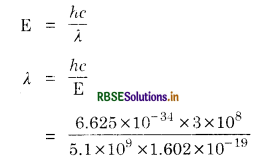
= 2.4392 x 10-16 m.
Question 11.25.
Estimating the following two numbers should be interesting. The first number will tell you why radio engineers do not need to worry much about photons. The second number tells you why our eye can never count photons, even in barely detectable light.
(a) The number of photons emitted per second by an MW transmitter of 10 kW power emitting radio waves of wavelength 500 m.
(b) The number of photons entering the pupil of our eye per second corresponding to the minimum intensity of white light that we humans can perceive (~ 10-10 Wm-2). Take the area of the pupil to be about 0.4 cm2, and the average frequency of white light to be about 6 x 1014 Hz.
Answer:
(a) Here,
Energy emitted per sec = 10 kW
E = 10 x 103 Js-1
λ = 500 m
Number of photons emitted per sec, n =?
From relation, c = vλ
Frequency of photon,
v = \(\frac{c}{\lambda}=\frac{3 \times 10^8}{500}\)
= 6 x 105 Hz.
Energy of each photon = hv
Number of photon's emitted per sec,
n = \(\frac{\mathrm{E}}{h v}\)
= \(\frac{10^3 \times 10^3}{6.626 \times 10^{-34} \times 6 \times 10^5}\)
= 2.52 x 1031 per sec.
We see that the energy of a radio photon is very small and the number of photons emitted per second in a radio beam is very large. There is, therefore, the negligible error involved in ignoring the existence of a minimum quantum of energy (photon) and treating the total energy of a radio wave as continuous.
(b) Energy entering the pupil of eye per sec,
E = intensity x area
= 10-10 x 0.4 x 10-4
= 4 x 10-15 J/s
Number of photons entering pupil per sec.
n = \(\frac{\mathrm{E}}{h v}\)
= \(\frac{4 \times 10^{-15}}{6.626 \times 10^{-34} \times 6 \times 10^5}\)
= 104 per sec.
Though this number is not as large as in (a) above, it is large enough for us never to 'sense' 'or count' individual photons by our eye.

Question 11.26.
Ultraviolet light of wavelength 2271 Å from a 100 W mercury source irradiates a photocell made of molybdenum metal. If the stopping potential is -1.3 V, estimate the work function of the metal. How would the photocell respond to a high intensity (~ 105 Wm-2) red light of wavelength 6328 Å produced by a He-Ne laser?
Answer:
h = 6.625 x 10-34 Js,
v = \(\frac{c}{\lambda}=\frac{3 \times 10^8}{22.71 \times 10^{-16}}\) Hz
V0 = -1.3 V
hv = \(\frac{1}{2}\)mv2 + W0
W0 = hv - eV0 = \(\frac{h c}{\lambda}\) - eV0 [∵ \(\frac{1}{2}\)mv2 = eV0]
= \(\frac{6.625 \times 10^{-34} \times 3 \times 10^8}{2271 \times 10^{-10}}\) - 1.6 x 10-19 x 1.3
= 6.67 x 10-19 J = 4.17 eV
Threshold frequency,
v0 = \(\frac{\mathrm{W}_0}{h}=\frac{6.67 \times 10^{-19}}{6.625 \times 10^{-34}}\)
= 1.0 x 1015 Hz.
Now, for red light,
λ = 6328 Å
v = \(\frac{c}{\lambda}=\frac{3 \times 10^8}{6328 \times 10^{-10}}\)
v =4.64 x 1014 Hz.
or
Now v < v0
The photocell will not respond to this frequency howsoever high be the intensity of laser light.
Question 11.27.
Monochromatic radiation of wavelength 640.2 nm (1 nm = 10-9 m) from a neon lamp irradiates a photosensitive material made of cesium or tungsten. The stopping voltage is measured to be 0.54 V. The source is replaced by an iron source and its 427.2 nm line irradiates the same photocell. Predict the new stopping voltage.
Answer:
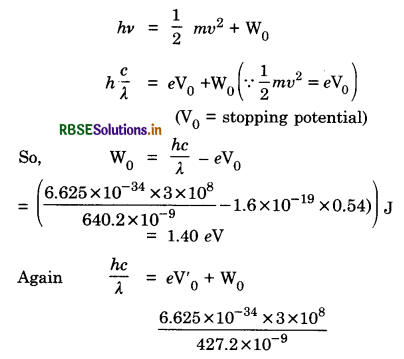
= 1.6 x 10-19 x V0' + 1.40 x 1.6 x 10-19
or V0' = 1.507 V. ≃ 1.5 V
Question 11.28.
A mercury lamp is a convenient source for studying frequency dependence of photoelectric emission since it gives a number of spectral lines ranging from the UV to the red end of the visible spectrum. In an experiment with rubidium photocell, the following lines from a mercury source were used:
λ1 = 3650 Å, λ2 = 4047 Å, λ3 = 4358 Å, λ4 = 5461 Å, λ5 = 6907 Å.
The stopping voltages respectively were measured to be:
V0 = 1.28 V, V0 = 0.95 V, V0 = 0.74 V, V0 = 0.16 V, V0 = 0 V.
(a) Determine the value of Planck's constant h.
(b) The threshold frequency and work function for the material.
Note: You will notice that to get h from the data, you will need to know e (which you can take to be 1.7 x 10-19 C). Experiments of this kind on Na, Li, K, etc. were performed by Millikan, who, using his own value of e (from the oil-drop experiment) confirmed Einstein's photoelectric equation and at the same time gave an independent estimate of the value of h.)
Answer:
v = c/λ, let us first calculate corresponding frequencies,
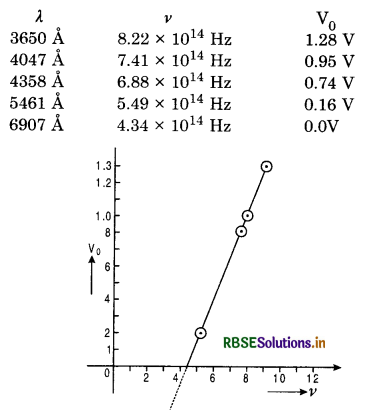
Obtain V0 versus v plot. The slope of the plot is h/e and its intercept on the y-axis is v0. The first four points lie nearly on a straight line which intercepts the y-axis at v0 = 5.0 x 1011 Hz. The fifth point corresponds to v < v0; there is no photoelectron emission and therefore no stopping voltage is required to stop the current.
Slope of the point is found to be
= 4.15 x 10-15 Vs.
Using e = 1.6 x 10-19 C,
h = 6.6426 x 10-34 Js
(standard value of h = 6.626 x 10-34 Js),
ω0 = hv = 2.11 V.

Question 11.29.
The work function for the following metals is given
Na: 2.75 V; K : 2.30 eV; Mo : 4.17 eV; Ni : 5.15 eV
Which of these metals will not give photoelectron emission for radiation of wavelength 3300 Å from a He-Cl laser placed 1 m away from the photocell? What happens if the laser is brought nearer and placed 50 cm away?
Answer:
The wavelength of incident radiation
λ = 3300 Å
v = \(\frac{c}{\lambda}=\frac{3 \times 10^8}{3300 \times 10^{-10}}\)
= 9.02 x 1014 Hz
Work function for Na,
ω0 = 2.75 eV = 2.75 x 1.6 x 10-19 J
Threshold frequency for Na,
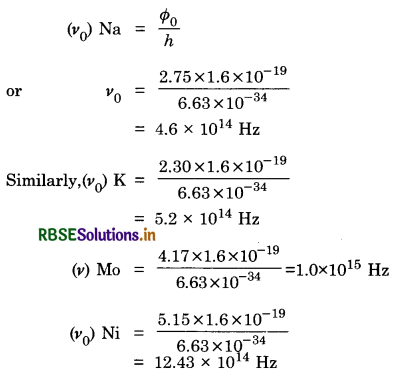
v0 (Na) and v0 (k); but less than v0 (Mo) and v0 (Ni). Therefore, Mo and Ni will not give photoelectron emission. If the laser is brought closer, intensity of radiation increases, but this does not affect the result regarding Mo and Ni; however, photoelectron current from Na and K will increase in proportion of intensity.
Question 11.30.
Light of intensity 10-5 Wm-2 falls on a sodium photocell of surface area 2 cm2. Assuming that the top 5 layers of sodium absorb the incident energy, estimate the time required for photoelectric emission on the wave picture of radiation. The work function for the metal is given to be about 2 eV. What is the implication of your answer?
Answer:
Assume one conduction electron per atom,
Effective atomic area ~ 10-20 m2.
No.of atoms per layer = \(\frac{2 \times 10^{-4}}{10^{-20}}\)
Number of electrons in 5 layers.
= \(\frac{5 \times 2 \times 10^{-4} \mathrm{~m}^2}{10^{-20} \mathrm{~m}^2}\) = 1017
Incident power = 10-5 Wm-2 x 2 x 10-4 m2
= 2 x 10-9 W
In the wave picture, incident power is uniformly absorbed by all the electrons continuously.
Consequently,
Energy absorbed per second per electron
= \(\frac{2 \times 10^{-9}}{10^{17}}\) W = 2 x 10-26 W
Energy required to come out = 20 eV
= 2 x 1.6 x 10-19 J
Time require for photoelectron emission
= \(\frac{2 \times 1.6 \times 10^{-19}}{2 \times 10^{-26}}\)
= 1.6 x 107 s = about 0.5 year
Implication: Experimentally photoelectron emission is observed nearly instantaneously (~ 10-9 s): experiment. In the photon picture, energy of the radiation is not continuously shared by all the electrons in the top layers. Rather, energy comes in discontinuous 'quanta'. A photon is either not absorbed, or absorbed, by an electron nearly instantly.
Question 11.31.
Crystal diffraction experiments can be performed using X-rays, or electrons accelerated through appropriate voltage. Which probe has greater energy? (For quantitative comparison, take the wavelength of the probe equal to 1 Å, which is of the order of inter-atomic spacing in the lattice), (me = 9.11 x 10-31 kg.)
Answer:
λ = 1 Å = 10-10 m
λ = \(\frac{h}{\sqrt{2 m_e \mathrm{E}}}\)
1 x 10-10 = \(\frac{6.625 \times 10^{-34}}{\sqrt{2 \times 9.1 \times 10^{-33} \times \mathrm{E}}}\)
or E = 150 eV
This gives the energy of electrons.
Energy of photon,
E = \(\frac{h c}{\lambda}\)
= \(\frac{6.625 \times 10^{-34} \times 3 \times 10^8}{1 \times 10^{-10} \times 1.6 \times 10^{-19}}\)
= 12.4 x 103 eV
= 12.4 keV.
Thus for the same wavelength, a photon has much greater energy than an electron.
Question 11.32.
(a) Obtain the de-Broglie wavelength of a neutron of kinetic energy 150 eV. As you have seen in Q. No. 11.31, an electron beam of this energy is suitable for crystal diffraction experiments. Would a neutron beam of the same energy be equally suitable? Explain. (mn = 1.675 x 10-27 kg).
(b) Obtain the de-Broglie wavelength associated with thermal neutrons at room temperature (27°C). Hence explain why a fast neutron beam needs to be thermalized with the environment before it can be used for neutron diffraction experiments.
Answer:
(a) λ = \(\frac{h}{p}=\frac{h}{(2 m \times \mathrm{K} \cdot \mathrm{E} .)^{1 / 2}}\)
Thus for the same K.E., λ decreases with m as \(\frac{1}{\sqrt{m}}\).
Now \(\frac{m_n}{m_0}=\frac{1.675 \times 10^{-37}}{9.11 \times 10^{-31}}\) = 1838.6
Therefore, for the same energy (150 eV) as in Q. No. 11.31, the wavelength of the neutron.
λ = \(\frac{1}{\sqrt{1838.6}}\) x 10-10 m
= 2.33 x 10-12 m
The interatomic spacing is about a hundred times greater. A neutron beam of 150 eV energy is therefore not suitable for diffraction experiments.
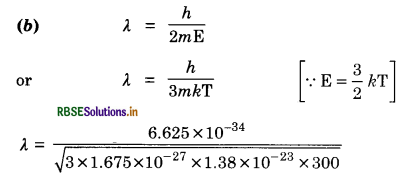
λ = 1.45 x 10-10 m
which is comparable to interatomic spacing in a crystal. Clearly, from (a) and (b) above, thermal neutrons are a suitable probe for diffraction experiments; so a high-energy neutron beam should be first thermalized before using it for diffraction.
Question 11.33.
An electron microscope uses electrons accelerated by a voltage of 50 kV. Determine the de-Broglie wavelength associated with the electrons. If other factors (such as numerical aperture etc.) are taken to be roughly the same how does the resolving power of an electron microscope compare with that of an optical microscope which uses yellow light?
Answer:
Taking V = 50 kV,
de-Broglie wavelength,
λ = \(\frac{12.27}{\sqrt{\mathrm{V}}}\) = 5.5 x 10-12 m
Given λ (yellow light) = 5.9 x 10-7 m
Resolving Power, RP ∝ \(\frac{1}{\lambda}\)
\(\frac{\text { R.P. (with electron) }}{\text { R.P. (with yellow light) }}=\frac{\lambda_{\text {light }}}{\lambda_{\text {electron }}} = \frac{5.9 \times 10^{-7}}{5.5 \times 10^{-12}}\) = 105.
Question 11.34.
The wavelength of a probe is roughly a measure of the size of a structure that it can probe in some detail. The quark structure of protons and neutrons appears at the minute length scale of 10-15 m or less. This structure was first probed in early 1970s using high-energy electron beams produced by a linear accelerator at Stanford, USA. Guess what might have been the order of energy of these electron beams. (Rest mass energy electron = 0.511 MeV).
Answer:
Using p = \(\frac{h}{\lambda}=\frac{6.63 \times 10^{-34} \mathrm{Js}}{10^{-15} \mathrm{~m}}\)
= 6.63 x 10-19 kg ms-1
Using the relativistic formula for energy:
E2 = c2p2 + m02c4
= 9 x (6.63)2 x 10-22 + (0.511 x 1.6)2 x 10-26
= 9 x (6.63)2 x 10-22
The second term (rest mass energy) being negligible. Therefore,
E = 1.989 x 10-10 J = 1.24 B eV
Thus electron energies from the accelerator must have been of the order of a few BeV.
Question 11.35.
Find the typical de-Broglie wave length associated with a He atom in helium gas at room temperature (27°C) and 1 atm pressure, and compare it with the mean separation between two atoms under these conditions.
Answer:
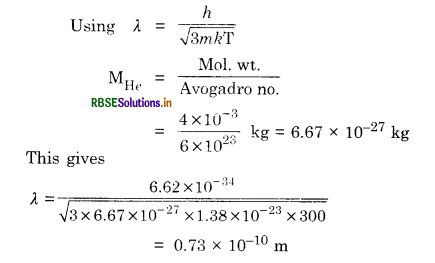
Mean separation,
r = \(\left(\frac{V}{N}\right)^{1 / 3}\)
For T = 300 K,
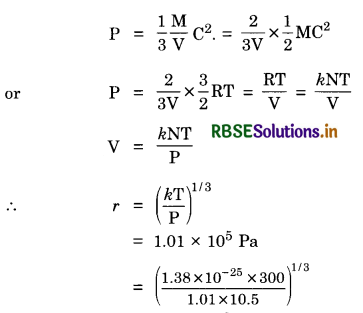
r = 3.4 x 10-9 m.
We find r > λ

Question 11.36.
Compute the typical de-Broglie wavelength of an electron in a metal at 27°C and compare it with the mean separation between two electrons in a metal which is given to be about 2 x 10-10 m.
[Note: Exercises 11.35 and 11.36 reveal that while the wave packets associated with gaseous molecules under ordinary conditions are non-overlapping, the electron wave-packet in a metal strongly overlap with one another. This suggests that whereas molecules in an ordinary gas can be distinguished apart, electrons in a metal cannot be distinguished apart from one another. This indistinguishability has many fundamental implications which you will explore in more advanced physics courses.]
Answer:
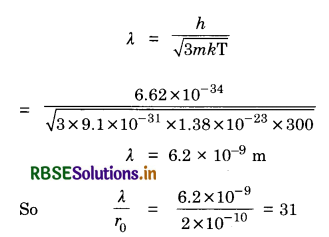
i.e. λ is 31 times the inter-electron separation (r0) in a metal.
Question 11.37.
Answer the following questions:
(a) Quarks inside protons and neutrons are thought to carry fractional charges \(\left(+\frac{2}{3} e,-\frac{1}{3} e\right)\). Why do they not show up in Millikan’s oil drop experiment?
(b) What is so special about the combination e/m? Why do we not simply talk of e and m especially?
(c) Why should gases be insulators at ordinary pressure and start conducting at very low pressure?
(d) Every metal has a definite work function. Why do photoelectrons not come out all with the same energy if incident radiation is monochromatic? Why is there an energy distribution of photoelectrons?
(e) The energy and momentum of an electron are related to the frequency and wavelength of the associated matter wave by the relations:
E = hv, p = \(\frac{\boldsymbol{h}}{\lambda}\).
But while the value of λ is physically significant, the value of v (and therefore the value of the phase speed vλ) has no physical significance. Why?
Answer:
(a) Quarks are thought to be confined within a proton or neutron by forces will grow stronger if one tries to pull them apart. It, therefore, seems that though fractional charges may exist in nature, observable charges are still integer multiples of e.
(b) Both the basic relations eV = \(\frac{1}{2}\) mv2 or eE = ma and eBv = \(\frac{m v^2}{r}\), for electric and magnetic fields, respectively, show that the dynamics of electrons is determined not by e, and m separately but by the combination e/m.
(c) At low pressure, ions have a chance to reach their respective electrodes and constitute a current. At ordinary pressure, ions have no chance to do so because of collisions with gas molecules and recombination.
(d) Work function merely indicates the minimum energy required for the electron in the highest level of the conduction band to get out of the metal. Not all electrons in the metal belong to this level. They occupy a continuous band of levels. Consequently, for the same incident radiation, electrons knocked off from different levels come out with different energies.
(e) The absolute value of energy E (but not momentum p) of any particle is arbitrary to within an additive constant. Hence while λ is physically significant, the absolute value of v of a matter wave of an electron has no direct physical meaning. The phase speed vλ is likewise not physically significant. The group speed is given by
\(\frac{d v}{d\left(\frac{1}{\lambda}\right)}=\frac{d \mathrm{E}}{d p}=\frac{d}{d p}\left(\frac{p^2}{2 m}\right)=\frac{p}{m}\)
is physcially meaningful.
SELECTED EXEMPLAR PROBLEMS
MCQ I (with one correct option)
Question 11.1.
A particle is dropped from a height H. The de-Broglie wavelength of the particle as a function of height is proportional to
(а) H
(b) H1/2
(c) H0
(d) H-1/2
Answer:
(d) velocity acquired by a body when dropped from height H is given by v = \(\sqrt{2 g \mathrm{H}}\)
Since de-Broglie wavelength
λ = \(\frac{h}{m v}=\frac{h}{m \sqrt{2 g \mathrm{H}}}=\frac{h}{m \sqrt{2 g} \sqrt{\mathrm{H}}}\)
or λ ∝ \(\frac{1}{\sqrt{H}}\)
or λ ∝ H-1/2.
Question 11.2.
The wavelength of a photon needed to remove a proton from a nucleus which is bound to the nucleus with 1 MeV energy is nearly
(а) 1.2 nm
(b) 1.2 x 10-3 nm
(c) 1.2 x 10-6 nm
(d) 1.2 x 101 nm
Answer:
(b) Given E = 1 MeV = 106 eV
Now hc = 1240 eV nm
Since E = \(\frac{h c}{\lambda}\)
∴ λ = \(\frac{h c}{\mathrm{E}}=\frac{1240}{10^6}\) = 1.24 x 10-3 nm.

Question 11.3.
Consider a beam of electrons (each electron with energy E0) incident on a metal surface kept in an evacuated chamber. Then
(а) no electrons will be emitted as only photons can emit electrons.
(b) electrons can be emitted but all with energy, E0.
(c) electrons can be emitted with any energy, with a maximum of E0 - Φ(Φ is the work function).
(d) electrons can be emitted with any energy, with a maximum of E0.
Answer:
(d) When beam of electrons falls on a surface, the electrons can be emitted with any energy with a maximum of E0.
Question 11.4.
A proton, a neutron, an electron, and an α-particle have the same energy. Then their de-Broglie wavelengths compare as
(а) λp = λn > λc > λα
(b) λα < λp = λn > λc
(c) λe < λp = λn > λα
(d) λc = λp = λn = λα
Answer:
(b) de-Broglie wavelength
λ = \(\frac{h}{m v}=\frac{h}{\sqrt{2 m \mathrm{E}}}\left[\begin{array}{c} \because \mathrm{E}=\frac{1}{2} m v^2 \\ \text { or } \quad v=\sqrt{\frac{2 \mathrm{E}}{m}} \end{array}\right]\)
i.e. λ ∝ \(\frac{1}{\sqrt{m}}\)
As, mp = mn ⇒ λp = λn
me < mn ⇒ λe > λn
mα > mp ⇒ λα < mp
∴ λα < λp = λn < λe
Question 11.5.
An electron is moving with an initial velocity \(\frac{h}{m v}\) = v0\(\hat{\mathbf{L}}\) and is in a magnetic field \(\overrightarrow{\mathbf{B}}\) = B0\(\hat{\mathbf{j}}\). Then its de-Broglie wavelength
(a) remains constant.
(b) increases with time.
(c) decreases with time.
(d) increases and decreases periodically.
Answer:
(a) Force on moving electron due to magnetic field =\( \overrightarrow{\mathrm{F}}=q(\vec{v} \times \overrightarrow{\mathrm{B}})=q\left(v_0 \mathrm{~B}_0\right)(\hat{i} \times \hat{j})=q v_0 \mathrm{~B}_0 \hat{k}\) \(\overrightarrow{\mathbf{F}}\) is ⊥ to \(\overrightarrow{\mathbf{v}}\) and \(\overrightarrow{\mathbf{B}}\), so v will not change, hence λ = \(\frac{h}{m v}\) will not change and λ will remain constant.

Question 11.6.
An electron (mass m) with an initial velocity v = v0 \(\overrightarrow{\mathbf{i}}\) (v0 > 0) is in an electric field E = -E0\(\overrightarrow{\mathbf{i}}\) (E0 = constant > 0). Its de-Broglie wavelength at time t is given by
(a) \(\frac{\lambda_0}{\left(1+\frac{e \mathrm{E}_0}{m} \frac{t}{v_0}\right)}\)
(b) λ0 \(\left(1+\frac{e \mathrm{E}_0 t}{m v_0}\right)\)
(c) λ0
(d) λ0t.
Answer:
(a) Initial de-Broglie wavelength of electron velocity of electron after time t
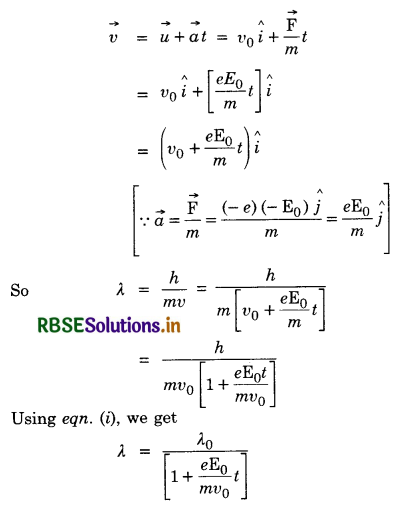
MCQ II. (with more than one correct options)
Question 11.7.
Relativistic corrections become necessary when the expression for the kinetic energy \(\frac{1}{2}\)mv2, becomes comparable with mc2, where m is the mass of the particle. At what de-Broglie wavelength will relativistic corrections become important for an electron?
(a) λ = 10 nm
(b) λ = 10-1 nm
(c) λ = 10-4 nm
(d) λ = 10-6 nm
Answer:
(c), (d)
Since de-Broglie wavelength λ is given by
λ = \(\frac{h}{m v}\), So v = \(\frac{h}{m \lambda}\)
(i) For λ = 10 nm = 10-8 m
v1 = \(\frac{6.6 \times 10^{-34}}{9 \times 10^{-31} \times 10^{-8}}\)
= \(\frac{2.2}{3}\) x 105 ≃ 105 ms-1
(ii) For λ = 10-1 nm = 10-10 m
v2 ≃ 107 ms-1
(iii) For λ = 10-4 nm = 10-13 m
v3 ≃ 1010 ms-1
(iv) For λ = 10-6 nm = 10-15 m
v4 ≃ 1012 ms-1
We find that v3 > c, v4 > c [3 x 108 ms-1], so relativistic correction required for λ = 10-7 nm and 10-6 nm.
Question 11.8.
Two particles A1 and A2 of masses m1, m2 (m1 > m2) have the same de-Broglie wavelength. Then
(a) their momenta are the same.
(b) their energies are the same.
(c) energy of A1 is less than the energy of A2.
(d) energy of A1 is more than the energy of A2.
Answer:
(a), (c) Since λ1 = \(\frac{h}{p_1}\) and λ2 = \(\frac{h}{p_2}\)
As λ1 = λ2, so p1 = p2
Since E = \(\frac{p^2}{2 m}=\frac{h^2}{2 m \hat{\lambda}^2}\)
or E ∝ \(\frac{1}{m}\) so \(\frac{\mathrm{E}_1}{\mathrm{E}_2}=\frac{m_2}{m_1}\) < 1 [∵ m1 > m2]
so E1 < E2.

Question 11.9.
Photons absorbed in matter are converted to heat. A source emitting n photon/sec of frequency v is used to convert 1 kg of ice at 0°C to water at 0°C. Then, the time t taken for the conversion.
(а) decreases with increasing n, with v fixed.
(b) decreases with n fixed, v increasing
(c) remains constant with n and v changing such that nv = constant.
(d) increases when the product nv increases.
Answer:
(a), (b), (c)
Energy used to convert ice into water = mL
Energy of photons = nTE = nThv
∴ nThv = mL
or T = \(\frac{m \mathrm{~L}}{n h v}\)
Very Short Answer Type Questions
Question 11.10.
A proton and an α-particle are accelerated, using the same potential difference. How are the de-Broglie wavelengths λp and λα related to each other?
Answer:
Since \(\frac{\lambda_p}{\lambda_\alpha}=\frac{p_\alpha}{p_p}=\frac{\sqrt{2 m_\alpha \mathrm{E}_\alpha}}{\sqrt{2 m_p \alpha_p}}=\frac{\sqrt{8}}{1}\) [∵ p = \(\sqrt{2 m \mathrm{E}}\)]
Question 11.11.
(i) In the explanation of photo-electric effect, we assume one photon of frequency v collides with an electron and transfers its energy. This leads to the equation for the maximum energy Emax of the emitted electron as
Emax = hv - Φ0
where Φ0 is the work function of the metal. If an electron absorbs 2 photons (each of frequency v) what will be the maximum energy for the emitted electron?
(ii) Why is this fact (two-photon absorption) not taken into consideration in our discussion of the stopping potential?
Answer:
(i) When 2 photons are absorbed
Emax = 2hV - Φ
The probability of absorbing 2 photons by the same electron is very low. Hence such emission is negligible.

Question 11.12.
There are materials that absorb photons of shorter wavelengths and emit photons of longer wavelengths. Can there be stable substances that absorb photons of larger wavelengths and emit light of shorter wavelengths?
Answer:
In Ist case, photons of high energy are absorbed and photons of lower energy are emitted. This is allowed.
In 2nd case, it is not possible for stable substances to absorb photons of low energy and emit photons of higher energy.
Question 11.13.
Do all the electrons that absorb a photon comes out as photoelectrons?
Answer:
No, most of the electrons get scattered into the metal. Only a few come out of the surface of the metal.
Question 11.14.
There are two sources of light, each emitting with a power of 100 W. One emits X-rays of wavelength 1 nm and the other visible light at 500 nm. Find the ratio of the number of photons of X-rays to the photons of visible light of the given wavelength?
Answer:
Let n1 and n2 be the number of photons of X-rays and visible regions and total energy is constant
∴ n1E1 = n2E2
or n1\(\frac{h c}{\lambda_1}\) = n2\(\frac{h c}{\lambda_2}\)
or \(\frac{n_1}{n_2}=\frac{\lambda_1}{\lambda_2}=\frac{1}{500}\)
Short Answer Type Questions
Question 11.15.
Consider Fig. EP 11.9 for photoemission.
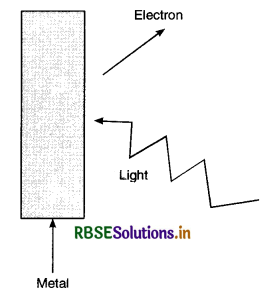
How would you reconcile with momentum conservation? Note light (photons) has momentum in a different direction than the emitted electrons.
Answer:
Momentum of photon is transferred to the metal and is absorbed by the atom (at microscopic level) and is transferred mainly to the nucleus and the electrons. The excited electron is emitted. Conservation of momentum is accounted for the momentum transferred to the nucleus and electrons.

Question 11.16.
Consider a metal exposed to light of wavelength 600 nm. The maximum energy of the electron doubles when light of wavelength 400 nm is used. Find the work function in eV.
Answer:
Kmax = 2Kmax
λ = 600 nm, λ' = 400 nm, Φ0 =?
Since Kmax = \(\frac{h c}{\lambda}\) - Φ0
and 2Kmax = \(\frac{h c}{\lambda^{\prime}}\) - Φ0
∴ 2\(\left(\frac{h c}{\lambda}-\phi_0\right)\) = \(\frac{1230}{400}\) - Φ0 [∵ hc = 1230 nm]
2(\(\frac{1230}{600}\) - Φ0) = \(\frac{1230}{400}\) - Φ0
or Φ0 = \(\frac{1230}{1200}\) = 1.02 eV.
Question 11.17.
Assuming an electron is confined to a 1 nm wide region, find the uncertainty in momentum using the Heisenberg Uncertainty principle. You can assume the uncertainty in position Ax as 1 nm. Assuming p ≃ ∆p, find the energy of the electron in electron volts.
Answer:
From uncertainty principle
∆x.∆p = h [h = \(\frac{h}{2 \pi}\) = 1.05 x 10-34 Js]
∆p = \(\frac{\hbar}{\Delta x}=\frac{1.05 \times 10^{-34}}{10^{-9}}\)
= 1.05 x 10-25
And E = \(\frac{p^2}{2 m}=\frac{(\Delta p)^2}{2 m}\)
= \(\frac{(1.05)^2 \times 10^{-50}}{2 \times 9.1 \times 10^{-16} \times 1.6 \times 10^{-19}} \mathrm{eV}\)
or E = 3.8 x 10-2 eV.
Question 11.18.
Two monochromatic beams A and B of equal intensity I hit a screen. The number of photons hitting the screen by beam A is twice that by beam B. Then what inference can you make about their frequencies?
Answer:
Here I = nAvA = nBvB
\(\frac{n_{\mathrm{A}}}{n_{\mathrm{B}}}=\frac{v_{\mathrm{B}}}{v_{\mathrm{A}}}\)
or \(\frac{2}{1}=\frac{v_{\mathrm{B}}}{v_{\mathrm{A}}}\)
or vB = 2vA.
Question 11.19.
A neutron beam of energy E scatters from atoms on a surface with a spacing d = 0.1 nm. The first maximum of intensity in the reflected beam occurs at θ = 30. What is the kinetic energy E of the beam in eV?
Answer:
Given d = 0.1 nm = 10-10 m
From Bragg’s law
λ = 2d sin θ = 2 x d x \(\frac{1}{2}\)
d = 10-10 m
p = \(\frac{h}{\lambda}=\frac{6.6 \times 10^{-34}}{10^{-10}}\)
= 6.6 x 10-24 kg ms-1
So E = \(\frac{p^2}{2 m} \mathrm{~J}=\frac{p^2}{2 m \times 1.6 \times 10^{-19}} e \mathrm{~V}\)
= \(\frac{(6.6)^2 \times 10^{-48} \times 1.6 \times 10^{-19}}{2 \times 1.67 \times 10^{-27}} e \mathrm{~V}\)
or E = 0.21 eV.
Long Answer Type Questions
Question 11.20.
Consider a thin target (10-2 m square, 10-3 m thickness) of sodium, which produces a photocurrent of 100 µA when light of intensity 100W/m2 (λ = 660 nm) falls on it. Find the probability that a photoelectron is produced when a photon strikes a sodium atom. [Take the density of Na = 0.97 kg/m3].
Answer:
6 x 1026 Na atoms weighs 23 kg.
Volume of target = (10-4 x 10-3) = 10-7 m3
Density of sodium = (d) = 0.97 kg/m3
Volume of 6 x 1026 Na atoms = \(\frac{23}{0.97}\) m3 = 23.7 m3
Volume of 1 Na atom = \(\frac{23}{0.97 \times 6 \times 10^{26}}\) m3
= 3.95 x 10-26 m3
No.of sodium atoms in the target = \(\frac{10^{-7}}{3.95 \times 10^{-26}}\) = 2.53 x 1018
Number of photon/s in the beam for 10-4 m2 = n
Energy per second = nhv = 10-4 J x 100 = 10-2 W
hv (for λ = 660 nm) = \(\frac{1234.5}{600}\)
= 2.05 eV = 2.05 x 1.6 x 10-19
= 3.28 x 10-19 J
n = \(\frac{10^{-2}}{3.28 \times 10^{-19}}\) = 3.05 x 1016/s
n = \(\frac{1}{3.2}\) x 1017 = 3.1 x 1016
If P is the probability of emission per atom, per photon, the number of photoelectrons emitted/second = P x 3.1 x 1016 x 2.53 x 1018
Current = P x 3.1 x 10+16 x 2.53 x 1018 x 1.6 x 10-19 A
= P 1.25 x 10+16A
This must equal 100 µA or
P = \(\frac{100 \times 10^{-6}}{1.25 \times 10^{+16}}\)
∴ P = 8 x 10-21
Thus the probability of photoemission by a single photon on a single atom is very much less than 1. (That is why the absorption of two photons by an atom is negligible).

Question 11.21.
Consider an electron in front of the metallic surface at a distance d (treated as an infinite plane surface). Assume the force of attraction by the plate is given as \(\frac{1}{4} \frac{q^2}{4 \pi \varepsilon_0 d^2}\). Calculate work in taking the charge to an infinite distance from the plate. Taking d = 0.1 nm, find the work done in electron volts. [Such a force law is not valid for d < 0.1 nm].
Answer:
Force of attraction by the plate on the electron if it is at a distance X is given by
F = \(\frac{1}{4} \frac{q^2}{4 \pi \varepsilon_0 x^2}\)
Total W.D. in taking the electron from x = d to x = α, will be
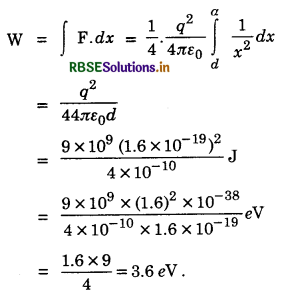
Question 11.22.
A particle A with mass mA is moving with velocity v and hits particle B (mass mB) at rest (one-dimensional motion) find change in the de-Broglie wavelength of particle A. Treat the collision as elastic.
Answer:
From law of conservation of momentum
mAv + mBv = mAv1 + mBv2
or mA (v - v1) = mBv2 ..................(i)
From law of conservation of kinetic energy
\(\frac{1}{2}\)mAv2 + \(\frac{1}{2}\)m20 = \(\frac{1}{2}\)mAv12 + \(\frac{1}{2}\)mBv22
or mA (v2 - v12) = mBv22
or mA (v - v1) (v + v1) = mBv22 ..................(ii)
Dividing eq.(ii) by eq. (i), we get
v + v1 = v2
or v = v2 - v1 ........................(iii)
From eq.(iii) in eq. (i), after little calculations, we get
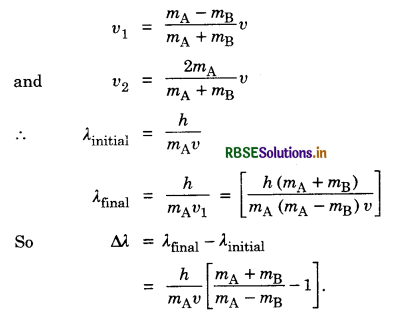

Question 11.23.
Consider a 20 W bulb emitting light of wavelength 5000 Å and shining on a metal surface kept at a distance 2 m. Assume that the metal surface has a work function of 2eV and that each atom on the metal surface can be treated as a circular disc of radius 1.5 A.
(i) Estimate no.of photons emitted by the bulb per second. [Assume no other losses]
(ii) Will there be photoelectric emission?
(iii) How much time would be required by the atomic disc to receive energy equal to the work function (2 eV)?
(iv) How many photons would an atomic disc receive within the time duration calculated in (iii) above?
(v) Can you explain how the photoelectric effect was observed instantaneously?
[Hint: Time calculated in part (iii) is from classical consideration and you may further take the target of the surface area say 1 cm2 and estimate what would happen?]
Answer:
(i) No. of photons emitted by bulb per second
\(\frac{d \mathrm{~N}}{d t}=\frac{\mathrm{P}}{\frac{h c}{\lambda}}=\frac{\mathrm{P} \lambda}{h c}=\frac{20 \times 5000 \times 10^{-10}}{6.62 \times 10^{-34} \times 3 \times 10^8}\)
= 5 x 1019 s-1
(ii) Energy of incident photon
E = \(\frac{h c}{\lambda}=\frac{6.62 \times 10^{-34} \times 3 \times 10^8}{5000 \times 10^{-10} \times 1.6 \times 10^{-19}}\)eV = 2.8 eV
Since 2.8 is more than work function 2eV, hence photoelectric emission will take place.
(iii) If ∆t is the time spent in getting energy 2eV, then
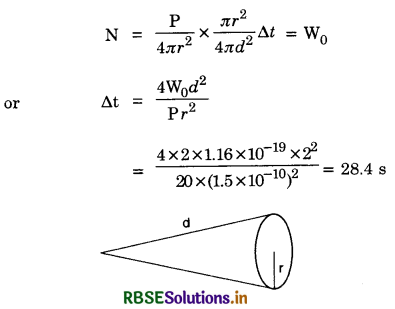
(iv) Number of photons received by an atomic disc in time ∆t
N = \(\left(\frac{d \mathrm{~N}}{d t}\right) \times \frac{\pi r^2}{4 \pi d^2}\).∆t
= \(\frac{5 \times 10^{-19}\left(1.5 \times 10^{-10}\right)^2 \times 28.4}{4 \times 2^2}\) = 2
(v) Here we find that the time of emission of electrons is 11.04 s, so photoelectric emission is not instantaneous. [In general, the time of emission is about 10-9 s, which is called instantaneous emission]

- RBSE Class 12 Physics Notes Chapter 2 स्थिर वैद्युत विभव तथा धारिता
- RBSE Class 12 Physics Notes Chapter 3 विद्युत धारा
- RBSE Class 12 Physics Notes Chapter 4 गतिमान आवेश और चुंबकत्व
- RBSE Class 12 Physics Notes Chapter 5 चुंबकत्व एवं द्रव्य
- RBSE Class 12 Physics Notes Chapter 6 वैद्युत चुंबकीय प्रेरण
- RBSE Class 12 Physics Notes Chapter 7 प्रत्यावर्ती धारा
- RBSE Class 12 Physics Notes Chapter 8 वैद्युतचुंबकीय तरंगें
- RBSE Class 12 Physics Notes Chapter 9 किरण प्रकाशिकी एवं प्रकाशिक यंत्र
- RBSE Class 12 Physics Notes Chapter 10 तरंग-प्रकाशिकी
- RBSE Class 12 Physics Notes Chapter 11 विकिरण तथा द्रव्य की द्वैत प्रकृति
- RBSE Class 12 Physics Notes Chapter 12 परमाणु